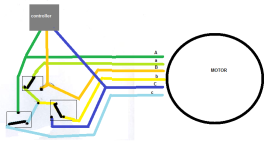Hi,
i recently got a new motor, 45mm stator and 9x11 winding, doing about 65kmh on 72v 60a
it has slots for wires on both sides of the motor, i'm thinking about getting 6 phase wires (3 from each side) in it and to make a delta\star switch to make it go 80-90kmh
i searched the forum and still cant understand how relays work and how they will change my motor from Wye to Delta in one switch, i would like to hear an explenation
also what relays do i need? i want to have something that could take more than what i give, so there will be no heat problems
Thanks,
Noam
i recently got a new motor, 45mm stator and 9x11 winding, doing about 65kmh on 72v 60a
it has slots for wires on both sides of the motor, i'm thinking about getting 6 phase wires (3 from each side) in it and to make a delta\star switch to make it go 80-90kmh
i searched the forum and still cant understand how relays work and how they will change my motor from Wye to Delta in one switch, i would like to hear an explenation
also what relays do i need? i want to have something that could take more than what i give, so there will be no heat problems
Thanks,
Noam



